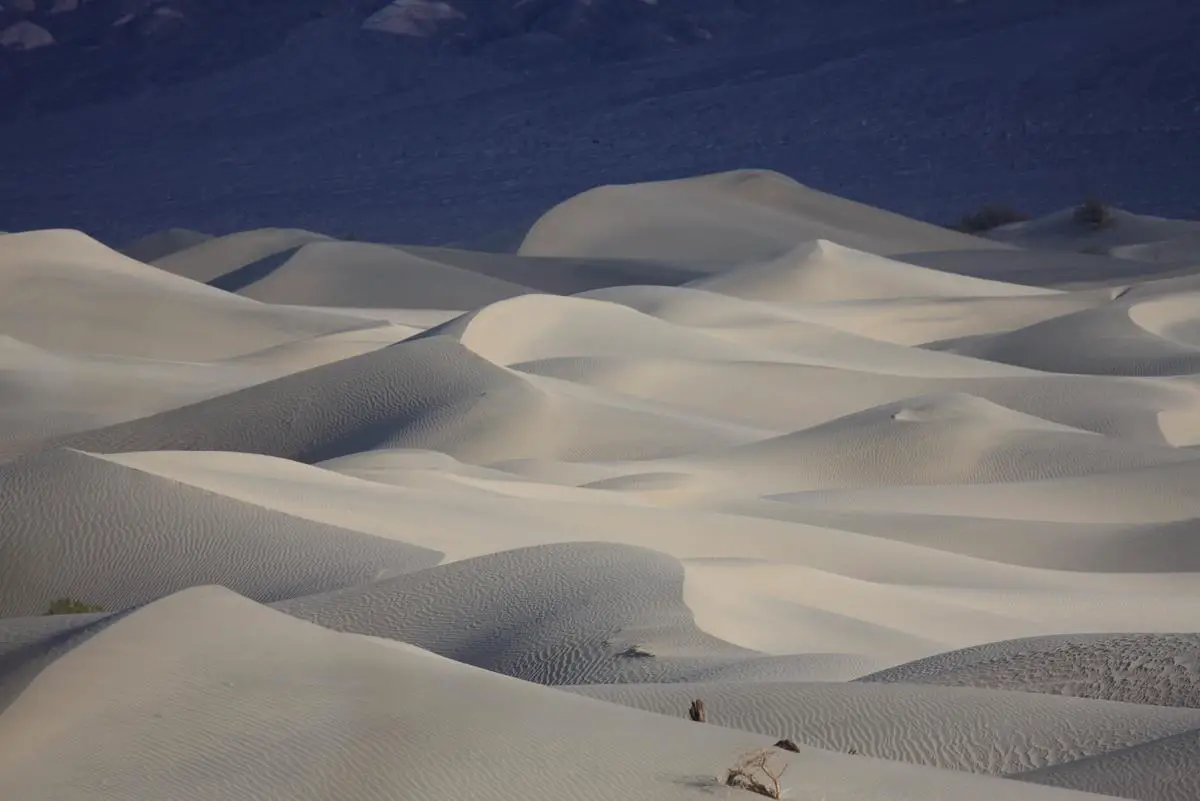Furnace Creek, Death Valley, California
On July 10, 1913, Furnace Creek in Death Valley, California recorded a scorching 56.7°C (134°F), earning its title as the hottest place on Earth. This blistering heat record still stands unmatched globally.
The landscape is as harsh as you'd expect – rolling dunes, rocky terrain, and relentless sun. But beneath this seemingly lifeless exterior, an ecosystem thrives with life adapted to the intense heat.
Hardy roadrunners dash across the scorched ground, while chuckwallas hide in rock crevices during peak heat. Even fish survive here – the desert pupfish inhabits small, isolated saline pools.
The kangaroo rat showcases impressive adaptations. Weighing only a few ounces, it rarely needs to drink water, deriving moisture from seeds. It can also jump up to nine feet to evade predators.
Ground temperatures can soar even higher than air temperatures. On July 15, 1972, the ground reached a staggering 93.9°C (201°F). Needless to say, barefoot walks are ill-advised!
The Furnace Creek Visitor Center provides a cool haven for curious minds, though stepping outside feels like entering an oven. It gives you a new appreciation for the resilience of the local wildlife.
While human presence is limited, life thrives in its own harsh way. The broader Death Valley area is also home to Rüppell's fox, sand cat, and various scorpions.
Death Valley's enduring wildlife tells an inspiring tale of adaptation. From sprinting roadrunners to burrowing chuckwallas, life finds a way in Earth's hottest known habitat.

Lut Desert, Iran
The Lut Desert in Iran gives Furnace Creek a run for its money. In 2005, NASA's satellites recorded a land surface temperature of 70.7°C (159.3°F), making Death Valley seem almost mild in comparison.1
The Lut's landscape is otherworldly – vast plains of dark sand, winding dunes, and salt flats under a sky that feels like an oven. Volcanic formations called yardangs stand like sentinels, contributing to the extreme heat by absorbing and retaining it.
Despite the brutal conditions, life persists. Here are some of the resilient creatures that call the Lut Desert home:
- Rüppell's fox: Roams under cover of darkness to avoid the scorching sun
- Sand cat: Thrives, camouflaging with its sandy environment
- Golden Scorpion: Scuttles across the scalding ground unfazed
- Arrow snake: Slithers through extreme temperatures
Even microorganisms find a way to survive, clinging to rocks and absorbing scant moisture. It's a stark reminder of nature's resilience and adaptability.
The Lut Desert embodies the saying, "life finds a way." While you might not want to book a summer holiday here, it stands as a compelling portrait of nature's tenacity.
If you're ever tempted to test your adventurer spirit in the Lut, bring plenty of water and sun protection. You'll appreciate its harsh beauty, but remember – it's the epitome of extremes.

Other Notable Hot Spots Globally
Let's explore more of Earth's sweltering frontiers:
| Location | Temperature Record | Notable Features |
|---|---|---|
| Kebili, Tunisia | 55°C (131°F) on July 7, 1931 | One of the earliest human settlements in Tunisia, dating back over 200,000 years |
| Mitribah, Kuwait | 53.9°C (129°F) on July 21, 2016 | Weather station sits in a desolate expanse, searing winds add to the oppressive heat |
| Tirat Tsvi, Israel | 54°C (129°F) on June 21, 1942 | Farming kibbutz using ingenious agricultural techniques and irrigation methods |
| Turbat, Pakistan | 53.7°C (128.7°F) on May 28, 2017 | Residents incorporate traditional cooling methods and siestas into daily routine |
| Oodnadatta, Australia | 50.7°C (123°F) on January 2, 1960 | Outback town epitomizing hardy lifestyle in extreme conditions |
| Athens, Greece | 48.0°C (118.4°F) on July 10, 1977 | Historic marvels and modern vibrancy coexist amid occasional heatwaves |
Each of these locations demonstrates human resilience and natural adaptation in the face of extreme temperatures. If you ever visit, be prepared, stay hydrated, and marvel at life's tenacity in Earth's hottest corners.
Temporary vs. Consistent Heat Spots
Understanding Earth's hottest places involves distinguishing between temporary and consistent high-temperature zones. This difference shapes not just the climate but also the life forms inhabiting these regions.
The Danakil Depression in Ethiopia exemplifies a consistent heat fixture. Temperatures regularly exceed 45°C (113°F) year-round. Its geographical and geological setup, including its below-sea-level location and volcanic activity, contributes to this constant heat.
In such consistently hot areas, flora and fauna must continuously adapt. The Afar people, who inhabit parts of this area, have built homes with light materials for ventilation and practice transhumance – moving livestock to cooler grazing grounds seasonally.
Unique and resilient species have evolved here. Extremophile microorganisms thrive in highly acidic, salty, and hot conditions that would be lethal to other life forms. Their resilience offers valuable insights into life's adaptability, possibly even in extraterrestrial environments.2
In contrast, places experiencing temporary extreme temperatures, like Mitribah, Kuwait, undergo a different adaptation cycle. Plants and animals can enter dormancy or change behaviors based on seasons. Flora tends to be more seasonal, with some plants flowering exclusively during milder months.
Adaptations in Temporary Heat Zones:
- Air conditioning during sweltering months
- Seasonal shifts in culture and lifestyle
- Architectural adaptations (thick walls, small windows)
- Adjusted routines to avoid peak daytime temperatures
Both types of heat zones showcase life's remarkable adaptability on Earth. Temporary heat spots allow for seasonal adaptations, while consistent heat zones push nature and humanity to their adaptive limits. Each tells a unique story of survival and resilience in the face of relentless sun and heat.

Impact of Climate Change
The heat waves we're seeing today are part of a worrying trend driven by climate change. Global warming is making extreme temperatures more common and intense, breaking heat records worldwide.
In July 2023, Earth's average temperature hit 17.15°C (62.87°F), a new record that lasted just one day before being beaten again. This wasn't a one-off; it's part of a pattern we've been seeing for years. Even with La Niña's usual cooling effect, temperatures kept climbing, showing how human-caused climate change is overpowering natural climate cycles.
These rising temperatures have real consequences:
- Spark wildfires
- Worsen air quality
- Put vulnerable people at risk
- Accelerate ice melt in Greenland and Antarctica
- Raise sea levels
The heat is tough on ecosystems too. Marine heatwaves are bleaching coral reefs and killing sea creatures. On land, long droughts and intense heat are stressing plants and animals, many of which can't adapt fast enough1.
The heat is hitting farming communities hard, from Africa to India. It messes with growing seasons, reduces crop yields, and threatens food security for millions2.
Scientists predict heatwaves will get worse in the coming years unless we seriously cut greenhouse gas emissions. Every temperature spike is a wake-up call to rethink our carbon footprints and push for more sustainable policies.
Global warming isn't just a future problem – it's here now. It's time we take these warnings seriously, find ways to adapt, and work to lessen these effects. We owe it to our planet and future generations to turn today's heatwave lessons into real action.

In the face of relentless heat, whether in the constant scorch of Furnace Creek or the extreme peaks of Lut Desert, life shows remarkable resilience. These stories remind us that adaptation and perseverance are key to thriving even in the harshest conditions.
As we confront rising global temperatures, let these examples inspire us to find ways to endure and adapt.
![]()

I loved as much as you will receive carried out right here. The sketch is attractive, your authored material stylish. nonetheless, you command get got an nervousness over that you wish be delivering the following. unwell unquestionably come more formerly again since exactly the same nearly a lot often inside case you shield this hike.
Keep working ,fantastic job!
Heya! I’m at work browsing your blog from my new iphone! Just wanted to say I love reading your blog and look forward to all your posts! Carry on the great work!